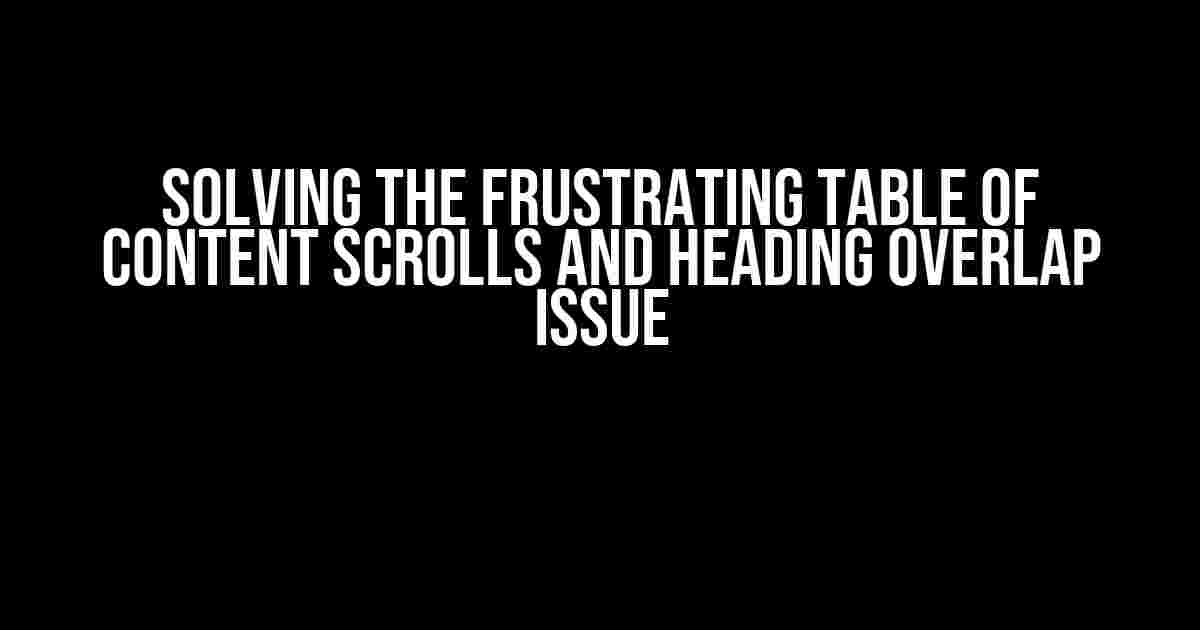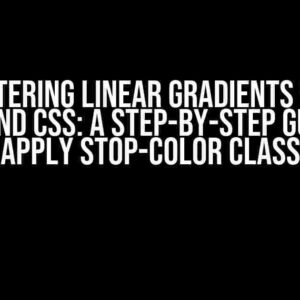Are you tired of dealing with the pesky problem of table of content scrolls that awkwardly overlap with your header? You’re not alone! This frustrating issue has plagued web developers and designers for years, causing headaches and ruining the overall user experience. But fear not, dear reader, for we’re about to dive into the solutions to this pesky problem.
Understanding the Problem
Before we dive into the solutions, let’s take a step back and understand the root of the problem. The issue arises when the table of content (TOC) scrolls and the heading shows behind the header, creating an overlapping mess. This occurs when the TOC is positioned as a sticky element, allowing it to remain fixed on the screen as the user scrolls.
This layout can be beneficial for providing easy access to the TOC, but it can also lead to the overlap issue. The problem is further exacerbated when the header has a background image, video, or color that reduces the readability of the heading.
Causes of the Problem
- The TOC is positioned as a sticky element using CSS.
- The header has a background image, video, or color that reduces readability.
- The TOC and header are not properly z-indexed, causing the overlap.
- The TOC container lacks a sufficient margin or padding to separate it from the header.
Solution 1: Adjusting the z-index
One of the simplest solutions to the overlap issue is to adjust the z-index of the TOC and header elements. By setting a higher z-index value for the header, you can ensure that it appears on top of the TOC, eliminating the overlap.
.header {
z-index: 2;
}
.toc {
z-index: 1;
}
Why it works
The z-index property determines the stack order of elements along the z-axis. By setting a higher z-index value for the header, we ensure that it appears on top of the TOC, preventing the overlap.
Solution 2: Adding Margin or Padding to the TOC Container
Another solution is to add a sufficient margin or padding to the TOC container, separating it from the header. This approach creates a clear visual distinction between the two elements, eliminating the overlap.
.toc-container {
margin-top: 50px; /* adjust the value according to your design */
}
Why it works
By adding a margin or padding to the TOC container, we create a clear visual separation between the TOC and header, preventing the overlap. This approach is particularly useful when the header has a complex background that would be disrupted by adjusting the z-index.
Solution 3: Using a Negative Margin on the TOC
A more creative solution involves using a negative margin on the TOC element itself. This approach pulls the TOC up and away from the header, preventing the overlap.
.toc {
margin-top: -50px; /* adjust the value according to your design */
}
Why it works
By applying a negative margin to the TOC, we effectively pull it up and away from the header, creating a clear separation between the two elements. This approach is particularly useful when the header has a fixed height.
Solution 4: Using CSS Positioning
Another solution involves using CSS positioning to reposition the TOC element relative to the header. This approach allows for more precise control over the layout and can be used in conjunction with other solutions.
.header {
position: relative;
}
.toc {
position: absolute;
top: 0;
left: 0;
margin-top: 50px; /* adjust the value according to your design */
}
Why it works
By setting the header to `position: relative`, we create a new containing block for the TOC element. We then use `position: absolute` on the TOC to reposition it relative to the header, creating a clear separation between the two elements.
Solution 5: Using a Third-Party Library or Plugin
Finally, if you’re using a JavaScript library or framework like jQuery, you can utilize a third-party plugin or library to tackle the overlap issue. These solutions often provide a more comprehensive and customizable approach to handling sticky elements and table of content scrolls.
Some popular libraries and plugins for handling sticky elements include:
- jQuery Sticky
- Sticky-kit
- Waypoints
Why it works
Third-party libraries and plugins provide a tried-and-tested solution to the overlap issue, often with a simple implementation process. These solutions can be particularly useful when working with complex layouts or legacy codebases.
Conclusion
In conclusion, the table of content scrolls and heading overlap issue is a frustrating problem that can be solved using a variety of approaches. By understanding the root cause of the problem and utilizing one or more of the solutions outlined above, you can create a seamless user experience that delights and engages your audience.
Remember to choose the solution that best fits your design and development constraints, and don’t be afraid to experiment and combine different approaches to achieve the desired result.
| Solution | Description | Pros | Cons |
|---|---|---|---|
| Adjusting z-index | Set a higher z-index value for the header | Easy to implement, minimal code required | Limited flexibility, may not work with complex layouts |
| Adding margin or padding to TOC container | Add a margin or padding to the TOC container | Creates a clear visual separation, flexible implementation | May require trial and error to find the right value |
| Using negative margin on TOC | Pull the TOC up and away from the header | Creates a clean separation, works well with fixed headers | May require adjustments to other layout elements |
| Using CSS positioning | Reposition the TOC relative to the header | Provides precise control over layout, flexible implementation | Requires a good understanding of CSS positioning |
| Using a third-party library or plugin | Utilize a tried-and-tested solution | Easy to implement, comprehensive solution | May require additional dependencies, potential conflicts |
We hope you found this article informative and helpful in solving the table of content scrolls and heading overlap issue. Remember to experiment, test, and refine your solution to achieve the best possible user experience.
Here are 5 Questions and Answers about “table of content scrolls and the heading shows behind the header” in a creative voice and tone:
Frequently Asked Question
Stuck with a stubborn table of content that refuses to behave? We’ve got you covered! Check out these frequently asked questions to get your TOC woes sorted.
Why does my table of content keep scrolling and hiding behind the header?
This is usually because of a CSS positioning issue. Try setting the position of your header to `relative` and the TOC to `absolute`, with a z-index higher than the header. This should fix the issue and keep your TOC visible.
How do I prevent the TOC from overlapping with the header?
Easy peasy! Just add a `margin-top` or `padding-top` to your TOC container that’s equal to the height of your header. This will create a buffer zone and prevent the TOC from overlapping with the header.
Can I use JavaScript to fix the TOC scrolling issue?
Yes, you can! You can use JavaScript to dynamically adjust the position of the TOC based on the scroll position of the user. There are many libraries and plugins available that can help you achieve this, such as Scrollspy or Waypoints.
Why does my TOC not stay fixed to the side of the page?
This might be due to a missing or incorrect CSS rule. Make sure you’ve set `position: fixed` and `top: 0` (or the desired position) on your TOC container. Also, ensure that the parent element has a non-static positioning (e.g., `relative` or `absolute`).
How do I make my TOC responsive and adapt to different screen sizes?
To make your TOC responsive, use media queries to adjust its width, height, and positioning based on different screen sizes. You can also use CSS frameworks like Bootstrap or Foundation that provide built-in responsive design features.


